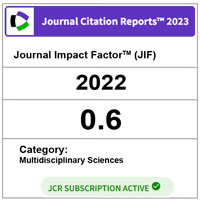Fluorine-free Superhydrophobic Stearic Acid Modified Kaolin Nanoparticles for Self-cleaning Silicone Rubber Surface
DOI:
https://doi.org/10.11113/mjfas.v20n3.3456Keywords:
Superhydrophobic, Fluorine-free, Nanoparticle modification, Self-cleaning surfaces, Kaolin-stearic acid compositeAbstract
This study introduces fluorine-free nanoparticles to innovate superhydrophobic surfaces for self-cleaning applications, addressing environmental concerns linked to fluorine-based compounds. The method involves modifying kaolin nanoparticles with stearic acid and integrating them into silicone. The surface of stearic acid-kaolin nanoparticles exhibits a contact angle of 149.4° ± 3.3, while the resulting composite film exhibits a contact angle of 113.9° ± 5.8. The surface roughness of the silicone rubber surfaces increases proportionally with higher concentrations of stearic acid-modified kaolin nanoparticles. Field Emission Scanning Electron Microscopy (FESEM) analysis demonstrates the successful coverage of kaolin nanoparticles-stearic acid on resulting film. Self-cleaning performance is evaluated by simulating the deposition of graphite powder onto the surfaces and subsequently observing the behaviour when water is dropped on them revealing their remarkable self-cleaning properties.
References
Parvate, S., Dixit, P., & Chattopadhyay, S. (2020). Superhydrophobic surfaces: insights from theory and experiment. The Journal of Physical Chemistry B, 124(8), 1323-1360.
Wang, Q., Sun, G., Tong, Q., Yang, W., & Hao, W. (2021). Fluorine-free superhydrophobic coatings from polydimethylsiloxane for sustainable chemical engineering: Preparation methods and applications. Chemical Engineering Journal, 426, 130829.
Lei, Y., Jiang, B., Liu, H., Zhang, F., An, Y., Zhang, Y., ... & Liu, T. (2023). Mechanically robust superhydrophobic polyurethane coating for anti-icing application. Progress in Organic Coatings, 183, 107795.
Ahmad, A., Albargi, H., Ali, M., Batool, M., Nazir, A., Qadir, M. B., ... & Harraz, F. A. (2023). Differential carbonization-shrinkage induced hierarchically rough PAN/PDMS nanofiber composite membrane for robust multimodal superhydrophobic applications. Journal of Science: Advanced Materials and Devices, 8(2), 100536.
Ye, Y., Li, T., Zhao, Y., Liu, J., Lu, D., Wang, J., ... & Cheng, X. (2023). Engineering environmentally friendly nanofiber membranes with superhydrophobic surface and intrapore interfaces for ultrafast Oil-water separation. Separation and Purification Technology, 317, 123885.
Li, Y. (2023). Theoretical analysis of contact angle hysteresis of suspended drops on micropillared superhydrophobic surfaces. Colloids and Surfaces A: Physicochemical and Engineering Aspects, 666, 131244.
Cao, H., Mao, Y., Wang, W., Jin, Y., Gao, Y., Zhang, M., ... & Song, Z. (2023). ZIF-8 based dual scale superhydrophobic membrane for membrane distillation. Desalination, 550, 116373.
Khodaei, M. (2019). Introductory Chapter: Superhydrophobic surfaces-introduction and applications. in superhydrophobic surfaces-fabrications to practical applications. IntechOpen.
Sun, Y., Zhao, H., Mao, H., Duan, M., Wang, K., Bao, N., ... & Li, H. (2023). Silica hollow spheres-based superhydrophobic PDMS composite membrane for enhanced acetone permselective pervaporation. Separation and Purification Technology, 304, 122041.
Darband, G. B., Aliofkhazraei, M., Khorsand, S., Sokhanvar, S., & Kaboli, A. (2020). Science and engineering of superhydrophobic surfaces: review of corrosion resistance, chemical and mechanical stability. Arabian Journal of Chemistry, 13(1), 1763-1802.
Lee, E. (2021). Simple fabrication of asphalt-based superhydrophobic surface with controllable wetting transition from Cassie-Baxter to Wenzel wetting state. Colloids and Surfaces A: Physicochemical and Engineering Aspects, 625, 126927.
Huré, M., Olivier, P., & Garcia, J. (2022). Effect of Cassie-Baxter versus Wenzel states on ice adhesion: A fracture toughness approach. Cold Regions Science and Technology, 194, 103440.
Feix, T., Fadhil, A. A., & Troegel, D. (2024). Leaching of catalyst platinum from cured silicone elastomers: A preliminary study for comparing reagents. Hydrometallurgy, 106283.
Wang, G., Li, A., Li, K., Zhao, Y., Ma, Y., & He, Q. (2021). A fluorine-free superhydrophobic silicone rubber surface has excellent self-cleaning and bouncing properties. Journal of Colloid and Interface Science, 588, 175-183.
Han, R., Wang, Z., Zhang, Y., & Niu, K. (2019). Thermal stability of CeO2/graphene/phenyl silicone rubber composites. Polymer Testing, 75, 277-283.
Sarkarat, M., Lanagan, M., Ghosh, D., Lottes, A., Budd, K., & Rajagopalan, R. (2020). High field dielectric properties of clay filled silicone rubber composites. Materials Today Communications, 23, 100947.
Rabia, S., Muhammad, M., Naveed, R., Waqas, A. S., & Qutab, H. G. (2020). Development of free fluorine and formaldehyde oil and water repellent finishes for cotton fabrics through polymerization of bio-based stearic acid with carboxylic acids. Industria Textila, 71(2).
Yang, L., Pang, Y., Chen, X., Tang, Q., Cui, H., Gao, D., & Chen, M. (2023). Effect of the stearic acid modified metakaolin on sulfate resistance of mortar based on the experimental study and capillary theory analysis. Journal of Building Engineering, 71, 106513.
Sharif, R., Mohsin, M., Ramzan, N., Ahmad, S. W., & Qutab, H. G. (2022). Synthesis and application of fluorine-free environment-friendly stearic acid-based oil and water repellent for cotton fabric. Journal of Natural Fibers, 19(5), 1632-1647.
Ahmad, N., Rasheed, S., Nabeel, M. I., Ahmad, W., Mohyuddin, A., Musharraf, S. G., ... & Hussain, D. (2023). Stearic acid and CeO2 nanoparticles co-functionalized cotton fabric with enhanced UV-block, self-cleaning, water-repellent, and antibacterial properties. Langmuir.
Badre, C., Pauporté, T., Turmine, M., & Lincot, D. (2007). A ZnO nanowire array film with stable highly water-repellent properties. Nanotechnology, 18(36), 36570.
Downloads
Published
Issue
Section
License
Copyright (c) 2024 Mohd Haiqal Abd Aziz, Khoirussolih Aminuddinan, Nor Aini Ijaman, Ahmad Faez Abdul Khalil, Mohd Ridhwan Adam

This work is licensed under a Creative Commons Attribution-NonCommercial 4.0 International License.









